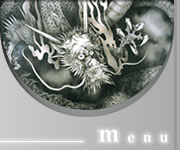
|
History
Shakyamuni to China
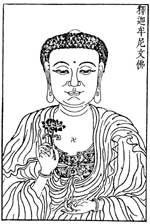 The history of Zen Buddhism started with Gautama Shakyamuni’s awakening to the True Dharma, the Buddha-nature inherent in all
beings. The lineage of the Zen School is traditionally regarded as having commenced with Shakyamuni’s transmission of the Mind Seal
( inka shomei 印可証明) to his disciple Mahakashyapa (see “Buddha Mind School”). With Shakyamuni’s recognition of
Mahakashyapa began the “direct transmission from
master to disciple” that Zen emphasizes as the particular characteristic of
its history as a tradition.
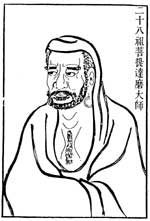 Mahakashyapa was followed in the traditional Zen lineage by Ananda, the
Buddha’s cousin and attendant who had failed to attain enlightenment while
the Buddha was alive, but who awakened to the Buddha Mind through the
guidance of Mahakashyapa. The Indian lineage continued until the
twenty-eighth patriarch, Bodhidharma, who transmitted the Zen teachings to
China in the early sixth century. Bodhidharma was succeeded by his disciple Huike 慧可
(487–593), a Chinese monk who, when he first visited the master, is said to
have demonstrated his determination by cutting off his arm. His
enlightenment is traditionally described as follows: Mahakashyapa was followed in the traditional Zen lineage by Ananda, the
Buddha’s cousin and attendant who had failed to attain enlightenment while
the Buddha was alive, but who awakened to the Buddha Mind through the
guidance of Mahakashyapa. The Indian lineage continued until the
twenty-eighth patriarch, Bodhidharma, who transmitted the Zen teachings to
China in the early sixth century. Bodhidharma was succeeded by his disciple Huike 慧可
(487–593), a Chinese monk who, when he first visited the master, is said to
have demonstrated his determination by cutting off his arm. His
enlightenment is traditionally described as follows:
Huike, the Second Patriarch, said to Bodhidharma, “My mind is not yet at
rest. Master, I implore you, set my mind to rest.” The master replied,
“Bring your mind here and I’ll set it to rest for you.” Huike said, “I have
searched for my mind, but am unable to find it.” “There,” said the master,
“I have set your mind to rest.”
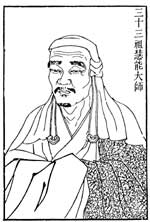 From Huike the Chinese patriarchate continued through Sengcan 僧璨 (the Third
Patriarch; d. 606?), Daoxin 道信 (the Fourth Patriarch; 580–651), and Hongren
弘忍 (the Fifth Patriarch; 600-674), to Huineng 慧能 (the Sixth Patriarch;
738ー713). Under Huineng, Zen took on a distinctly Chinese character with an
emphasis on “sudden awakening” to the Buddha-nature inherent in every being.
Huineng’s intuition of the universal nature of Buddha Mind was already
expressed in the story of his first encounter with the Fifth Patriarch:
It is said that when Huineng arrived at the monastery, Hongren asked about his origins.
Huineng replied that he had come from southern China. Hongren said that a
barbarian from the south can never become a Buddha. When Huineng responded,
“There is no north and south in Buddha nature,” Hongren sensed Huineng’s
ability and put him to work at the monastery as a rice huller. From Huike the Chinese patriarchate continued through Sengcan 僧璨 (the Third
Patriarch; d. 606?), Daoxin 道信 (the Fourth Patriarch; 580–651), and Hongren
弘忍 (the Fifth Patriarch; 600-674), to Huineng 慧能 (the Sixth Patriarch;
738ー713). Under Huineng, Zen took on a distinctly Chinese character with an
emphasis on “sudden awakening” to the Buddha-nature inherent in every being.
Huineng’s intuition of the universal nature of Buddha Mind was already
expressed in the story of his first encounter with the Fifth Patriarch:
It is said that when Huineng arrived at the monastery, Hongren asked about his origins.
Huineng replied that he had come from southern China. Hongren said that a
barbarian from the south can never become a Buddha. When Huineng responded,
“There is no north and south in Buddha nature,” Hongren sensed Huineng’s
ability and put him to work at the monastery as a rice huller.
Later Hongren, wishing to name a successor, asked the monks to write a verse
expressing their understanding. The first verse was that of the senior monk,
Shenxiu 神秀 (605–706), who wrote, “The body is the Bodhi tree, the mind is
like a clear mirror. At all times strive to polish it, and let no dust
collect.” The illiterate Huineng, after hearing another monk recite
Shenxiu’s verse, responded with a verse expressing the Zen understanding of
the essential nonsubstantiality of mind: “Originally there is no tree of
enlightenment, nor is there a stand with a clear mirror. From the beginning
not a single thing exists; where is there for dust to collect?” Hongren
approved of Huineng’s verse and transmitted the patriarchate to him.
The teaching line of Huineng flourished, eventually forming the mainstream
of Chinese Zen and giving rise to the various traditions known as the Five
Houses and Seven Schools.
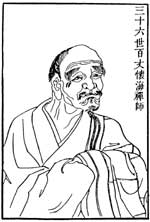 Three generations after Huineng, the master Baizhang Huaihai 百丈懷海 (J., Hyakujo Ekai; 749–814)
laid the foundations of the Zen monastic life, with manual labor as a
central part of the daily schedule (he is known for his famous dictum, “A
day of no work—a day of no eating”). His monastic rule, the Chanlin qinggui
禪林清規, no longer exists in its original form, but all subsequent forms of Zen
monasticism have been influenced by his ideas on meditation practice and
architectural design for the Zen monastery. Three generations after Huineng, the master Baizhang Huaihai 百丈懷海 (J., Hyakujo Ekai; 749–814)
laid the foundations of the Zen monastic life, with manual labor as a
central part of the daily schedule (he is known for his famous dictum, “A
day of no work—a day of no eating”). His monastic rule, the Chanlin qinggui
禪林清規, no longer exists in its original form, but all subsequent forms of Zen
monasticism have been influenced by his ideas on meditation practice and
architectural design for the Zen monastery.
Over the centuries two basic approaches to the practice of zazen emerged:
“silent illumination Zen” 黙照禪, which came to be associated principally with
the Caodong (J. Soto) school, and “koan-introspecting Zen” 看話禪, which came
to be associated principally with the Linji school.
Silent illumination Zen was promoted in the Tang dynasty by Shishuang
Qingzhu 石霜慶諸 (J., Sekiso Keisho, 807–888), who taught, “Cease and stop....
One thought—ten-thousand years. Be like a cold incense burner in an
abandoned temple.” Koan Zen developed when masters started to use the words
and actions of former Zen monks as expedients to help precipitate or clarify
understanding in the own students. It is advocated particularly by masters
like Fenyang Shanzhao 汾陽善昭 (J., Fun’yo Zensho; 947–l024), Yuanwu Keqin 圜悟克勤
(J., Engo Kokugon, 1063–1135), and Dahui Zonggao 大慧宗杲 (J., Daie Soko;
1089–1163).
The Five Houses and Seven Schools
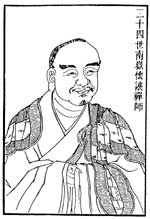 Among the successors of the Sixth Patriarch Huineng,
the two masters Nanyue Huairang 南嶽懷讓 (Nangaku
Ejo; 677–744) and Qingyuan Xingsi 青原行思 (J., Seigen Gyoshi; d. 740) were of
especial importance in the subsequent history of Zen, for it was their
lineages that produced all the later traditions of mainstream Chinese Zen ,
known, collectively, as the Five Houses. The Five Houses were:
1) the Linji 臨濟 (J., Rinzai) school, established by Nanyue Huairang’s
descendent Linji Yixuan 臨濟義玄 (J., Rinzai Gigen; d. 867);
2) the Guiyang 潙仰 (J., Igyo) school, established by Nanyue Huairang’s
descendant Guishan Lingyou 潙山靈祐 (J., Isan Reiyu, 771–853) and his disciple
Yangshan Huiji 仰山慧寂 (J., Kyozan Ejaku; 807–883);
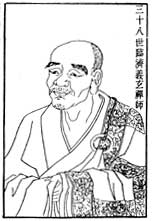 3) the Caodong 曹洞 (Jap., Soto) school, established by Qingyuan Xingsi’s
descendant Dongshan Liangjie 洞山良价 (J., Tozan Ryokai; 807–869) and Dongshan’s
student Caoshan Benji 曹山本寂 (J., Sozan Honjaku, 840–901); 3) the Caodong 曹洞 (Jap., Soto) school, established by Qingyuan Xingsi’s
descendant Dongshan Liangjie 洞山良价 (J., Tozan Ryokai; 807–869) and Dongshan’s
student Caoshan Benji 曹山本寂 (J., Sozan Honjaku, 840–901);
4) the Yunmen 雲門 (J., Unmon) school, established by Qingyuan Xingsi’s
descendant Yunmen Wenyan 雲門文偃 (J., Unmon Bun’en; 864–949);
5) the Fayan 法眼 (J., Hogen) school, established by Qingyuan Xingsi’s
descendant Fayan Wenyi 法眼文益 (J., Hogen Mon’eki, 885–958).
The Linji school was further divided into the Yangqi (Yogi) and Huanglong (Oryo)
teaching lines, which, together with the Five Houses, formed the Seven
Schools.
Although the Five Houses taught essentially the same Dharma as that
transmitted through the generations of meditation masters from the time of Shakyamuni Buddha, their respective teaching styles differed according to
the personalities of their founders. To summarize:
1. The Linji school was known for its emphasis on sudden awakening, its
occasionally rough teaching techniques (such as use of the shout and the
stick), and, from Song-dynasty times, its extensive use of the koans.
2. The Guiyang school was known for its combination of Guishan Lingyou’s
teaching on the unity of principle and function with Yangshan Huiji’s use of
esoteric symbols like the circle-figure 圓相. The school later declined, and
disappeared after about 150 years.
3. The Caodong school was known for its aversion to worldly involvement and
its emphasis on long sitting in “silent illumination” zazen (though koans
were also used). The Five Ranks doctrine was an important aspect of its
teaching. In Japan there is a particular stress on ritual practice and
the activities of everyday life. In China the school declined and
disappeared in Ming times (1368–1644); the school remains active in Japan.
4. The Yunmen school flourished greatly for several centuries after the time
of its founder, Yunmen Wenyan, especially among the educated elite. After
several centuries it declined, however, and disappeared during the Yuan era
(1280–1368). It was known for its terse, penetrating use of words, as
exemplified by the so-called “one-word barriers” of Yunmen.
5. The Fayan school was known for its literary efforts, whitch gave rise to the
classical Zen biographies and helped lay the foundations of koan Zen. Fayan-school
masters were active in the development of the koans, and in attempts to
combine zazen training with nenbutsu practice and Tiantai doctrine. In part
because of its syncretistic tendencies, it disappeared as a distinct school
after several generations, but its methods of koan work were assimilated into Linji Zen.
The Transmission of Zen to Japan
The Zen teachings
first reached Japan during the seventh century with the Japanese Hosso
school monk Dosho 道昭 (629–700), who traveled to Tang-dynasty China in 653.
There, in addition to his study of Yogacara under the great translator-monk
Xuanzang 玄奘 (602–664), he learned Zen meditation from Huiman 慧滿 (7 c.), a
disciple of the Second Patriarch, Huike. After returning to Japan he opened
the country’s first Zen meditation hall at Gango-ji 元興寺 in Nara. He was
followed in the eighth century by the Chinese Vinaya-school monk Daoxuan
道璨, who taught Zen meditation in addition to the vinaya. In the ninth
century the Chinese Zen master Ikong 義空 (J., Giku) came to Japan and taught for a
number of years before returning to China. None of these monks succeeded in
establishing a lasting lineage, however.
The Zen school took firm root in Japan only during the Kamakura era
(1192–1333) and early part of the Muromachi era (1336–1573), when changes in
the religious consciousness of the country led to greater interest in
various practices leading to personal liberation.
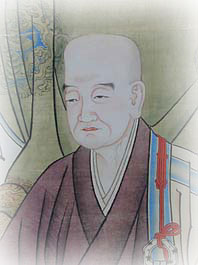 The first Japanese monk
to transmit the Rinzai teachings to Japan was the Japanese Tendai monk Myoan
Yosai [Eisai] 明菴榮西 (1141–1215). Born in present
Okayama Prefecture, he became a Tendai-school monk at the age of eleven and
studied the esoteric teachings of that tradition. He went to the Tendai
headquarters on Mt. Hiei two years later, and was ordained in 1154. In 1168
he traveled to China, where he studied the Tiantai teachings and practiced
Tiantai meditation methods for six months before returning to Japan. The first Japanese monk
to transmit the Rinzai teachings to Japan was the Japanese Tendai monk Myoan
Yosai [Eisai] 明菴榮西 (1141–1215). Born in present
Okayama Prefecture, he became a Tendai-school monk at the age of eleven and
studied the esoteric teachings of that tradition. He went to the Tendai
headquarters on Mt. Hiei two years later, and was ordained in 1154. In 1168
he traveled to China, where he studied the Tiantai teachings and practiced
Tiantai meditation methods for six months before returning to Japan.
Twenty years later, in
1187, he once again sailed for China, hoping to make a pilgrimage to India,
the home of Buddhism, in order further his goal of restoring Japanese Zen to
its original ideals. When the Chinese government refused him permission to
travel beyond its borders, Eisai made his way to Mount Tiantai and
undertook the practice of Linji (Rinzai) Zen with the Huanglong (Oryo) 黄龍
lineage master Xuan Huaichang 虚庵懷敞 (J., Koan Esho; n.d.), under whom he studied both
meditation and the vinaya.
In 1191 Eisai returned to
Japan, bringing not only the Rinzai Zen teachings but also the practice of
tea-drinking. He founded the monastery Shofuku-ji on the island of Kyushu,
avoiding the capital of Kyoto for the time being because of opposition to
the Zen teachings from the older established sects of Tendai and Shingon.
Later he did go to the capital to answer charges made against him by the
older schools, presenting his arguments in his chief work, the Kozen
Gokokuron (Propagation of Zen for protection of the nation). In 1199 he went
to Kamakura to assume the abbacy of the temple Jufuku-ji 壽福寺, built for him
by the Kamakura Shogunate. In 1202 he agreed to become abbot of the new
temple Kennin-ji in Kyoto, where, until the end of his life in 1215, he
taught a combination of Zen meditation with Tendai and Shingon ritual.
Although Eisai’s Oryo lineage did not continue long, he was important in
setting the stage for the restoration of monastic discipline and the
establishment of Zen meditation practice.
The transmission of the
Zen school to Japan continued after the time of Eisai through Japanese monks
who practiced Zen in China and Chinese masters who settled in Japan. Zen
tradition has it that the teachings were conveyed by a total of forty-six
masters, of whom twenty-four established lineages lasting at least a few
generations. Among these, the sole Rinzai lineage to flourish to the present
day is the so-called Otokan lineage of Nanpo Jomyo 南浦紹明 (1235ー1308), usually
known as Daio Kokushi 大應國師; his student Shuho Myocho 宗峰妙超 (1282-1337),
usually known as Daito Kokushi 大燈國師; and Shuho’s student Kanzan Egen 關山慧玄
(1277–1360). The term Otokan comes from the “o” of Daio, the “to” of Daito,
and the “kan” of Kanzan). This lineage has largely shaped Rinzai Zen
practice in Japan, and, through the eighteenth-century master Hakuin Ekaku,
includes every Rinzai Zen master in Japan today.
Nanpo Jomyo was a native
of Abe in present Shizuoka Prefecture. He entered the monkhood at the age of
fifteen, and at eighteen entered the monastery of Kencho-ji 建長寺, in the
shogun’s capital at Kamakura, to study under Lanxi Daolong 蘭溪道隆 (J., Rankei
Doryu; 1213-1278). In 1259 went to
China to study under Xutang Zhiyu 虚堂智愚 (J., Kido Chigu; 1185–1269), in
present-day Zhejiang. He received Xutang’s seal of transmission in 1265, and
returned to Japan in 1267. After spending several more years with his old
teacher Lanxi in Kamakura, he was appointed abbot of Kotoku-ji 興徳寺 on the
island of Kyushu in 1270. Three years later he became priest of Sofuku-ji 崇福寺
in nearby Dazaifu. There he lived and taught for thirty-three years, until
he was called to Kyoto in 1305 and appointed abbot of Manju-ji 萬壽寺. In 1307
he was appointed priest of Kencho-ji, where he died on 29 December 1308. He
was awarded the posthumous title National Teacher Enzu Daio 圓通大應國師.
Shuho Myocho was a native
of Harima in the region of present-day Hyogo. He was ordained at Enkyo-ji
圓鏡寺 on Mount Shosha at the age of eleven and studied Tendai doctrine. In
1301 he became a student of Koho Kennichi 高峰顯日 (1241–1316) at Manju-ji 萬壽寺
in Kamakura, then in 1304 went to Kyoto to study under Nampo Jomyo,
accompanying Nanpo to Kamakura when Nanpo was appointed abbot of Kencho-ji
in 1308. Just ten days after arriving at Kencho-ji, Myocho had a
breakthrough with the koan known as “Yunmen’s ‘Barrier’.” After Nanpo died
several months later, Shuho retumed to Kyoto and, according to legend, spent
twenty years living with beggars under the Gojo Bridge. Eventually Emperor Hanazono 花園 (r. 1308–1318), deciding to find him, went to the area with a
basket of melons and said to the beggars, “Take this melon without using
your hands.” One beggar replied, “Give it to me without using your hands,”
and the emperor knew this was Shuho.
In fact, Shuho appears to have spent
his years of seclusion at two small temples, Ungo-ji 雲居寺 in eastern Kyoto
and Daitoku-ji 大徳寺 in the northwestern part of the capital. The latter
temple was soon enlarged with the aid of the imperial court, and Shuho was
called to lecture before Emperor Hanazono, and, later, Emperor Go-Daigo 後醍醐
(r. 1318–1339). Shuho resided and taught at Daitoku-ji for the rest of his
life. At the time of his death Shuho forced his crippled leg into the full
lotus position (which broke the leg), wrote his death poem, and passed away.
Kanzan Egen, third in the Otokan lineage, was a native of Shinano in
present-day Nagano Prefecture; his family name was Takanashi. He received
ordination at Kencho-ji 建長寺 under the priest Toden Shikei 東傳士啓; in 1307 he
met Nanpo Jomyo, from whom he received the name Egen 慧玄. After Nanpo died in
1309, Egen returned to his native place until, in 1327, he met Nanpo’s
student Shuho Myocho and began his practice under him. In 1330 he
experienced a deep enlightenment. After receiving transmission from Myocho,
Kanzan is said to have gone to the mountain village of Ibuka in present-day
Gifu Prefecture, where he worked as a laborer and deepened his realization.
1337 he was called back to the capital and installed as the founding priest
of Myoshin-ji 妙心寺. There he taught a few students as well as the cloistered
emperor Hanazono. Kanzan is known for his austere lifestyle, and is said to
have died dressed in his pilgrimage clothes, standing under a tree.
Other important early Rinzai masters were:
Enni Ben’en 圓爾辯圓 (1201–1280) was born in Suruga, present Shizuoka
Prefecture, entered a temple at five and commenced Tendai studies at eight.
At eighteen he entered monastic life at the great Tendai temple Mii-dera,
and took the precepts at Todai-ji in Nara. His wide-ranging studies included
Confucianism, Abhidharma thought, and the exoteric and esoteric Tendai
teachings. In 1235 he left for a seven-year stay in China, where he
practiced under the eminent master Wuzhun Shifan 無準師範 (J., Bujun Shipan; 1177–1249). In 1241,
after receiving the seal of enlightenment from Wuzhun, Enni returned to
Japan and took up residence in Kyushu, where he established a number of Zen
monasteries. In 1243 the chancellor Kujo Michiie 九条道家 (1192–1252) invited
Enni to serve as the founding priest of Tofuku-ji 東福寺, a great Zen temple
planned by Michiie to compare in grandeur to the great temples of Todai-ji
東大寺 and Kofuku-ji 興福寺 in Nara. Enni was well prepared to lead the Shingon,
Tendai, and Zen practices that comprised the monastic training at Tofuku-ji
at that time. Enni also served as the tenth abbot of Kennin-ji,
simultaneously with his duties at Tofuku-ji. He was awarded the posthumous
title National Teacher Shoichi 聖一國師 by Emperor Hanazono. Though Enni’s
teachings combined Zen with Tendai and Shingon, he was instrumental in
helping the Zen school, still relatively new to Japan at the time, win
increasing acceptance and respect in the capital.
Shinchi Kakushin 心地覺心 (1207–1298), also known as National Teacher Hatto
Enmyo 法燈圓明國師, was a native of Shinshu (present Nagano Prefecture); his
family name was Tsunezumi. He became a monk at eighteen, and at twenty-nine
received the full precepts at the temple Todai-ji 東大寺 in the ancient capital
of Nara. Following this he studied esoteric Buddhism on Mount Koya 高野,
headquarters of the Japanese Shingon 眞言 school, where he met the Rinzai Zen
master Taiko Gyoyu 退耕行勇 (1163–1241), under whom he trained from 1239 to 1241
at the temples Kongo-zanmai-in 金剛三昧院 on Mount Koya and Jufuku-ji 壽福寺 in
Kamakura. In 1249, after further training with other masters, he embarked
for China to study under Wuzhun Shifan 無準師範 (1177–1249). Finding that Wuzhun
had died, Kakushin visited various important Buddhist centers until a fellow
Japanese monk named Genshin 源信 directed him to the Zen master Wumen Huikai
無門慧開 (J., Mumon Ekai; 1183–1260) of the temple Huguo Renwang si 護國仁王寺, near the city of
Hangzhou. In a well-known story, Kakushin, when asked by Wumen, “My place
has no gate; how did you get in?” answered, “I entered from no-gate (wumen).”
After a mere six months Kakushin received dharma transmission, along with
the gifts of a robe, a portrait of Wumen, and the Wumen guan 無門關 (Jap.,
Mumonkan), a collection of koans compiled by Wumen that has remained a
central text in Japanese Rinzai koan study. Following his return to Japan in
1254, Kakushin first resided on Mount Koya, then became abbot of the temple
Saiho-ji 西方寺 (later called Kokoku-ji 興國寺) in Yura, present Wakayama
Prefecture. He often lectured before the emperors Kameyama 龜山 (r. 1259–74) and
Go-Uda 後宇多 (r. 1274–87), and received from Kameyama the honorary title Zen
Master Hotto 法燈禪師; following his death he was designated National Teacher
Hotto Enmyo 法燈圓明國師 by Emperor Go-Daigo 後醍醐 (r. 1319–1339). Kakushin is
regarded as the founder of the influential Hotto 法燈 (also Hatto) line of
Rinzai Zen and of the Japanese Fuke school 普化宗, a tradition of largely lay
practicers who wandered about the country playing the shakuhachi 尺八, a
bamboo flute whose music was regarded as an aid to enlightenment.
Lanxi Daolong 蘭溪道隆 (J. Rankei Doryu; 1213–1278) was a native of the
present-day Sichuan region of China. He entered temple life at the age of
thirteen, studying under the masters Wuzhun Shifan 無準師範 (1177–1249), Chijue
Daochong 癡絶道冲 (J., Chizetsu Dochu; 1169–1250), and others, and succeeding to the dharma of Wuming Huixing 無明慧性 (J.,
Mumyo Esho; 1162–1237). In 1246 he and several of his disciples
came to Japan, first to the southern island of Kyushu and later, at the
invitation of the regent Hojo Tokiyori 北条時頼 (1227–1263), to the city of Kamakura,
the capital of the shogunate. There in 1253, under Tokiyori’s patronage, he
was named founding priest of Kencho-ji 建長寺, Japan’s first true Rinzai Zen
monastery. Later Lanxi moved to Kyoto and was appointed abbot of Kennin-ji,
Yosai’s part-Zen, part-Tendai temple that Lanxi reorganized as a center of
pure Zen training. After returning to Kamakura he served again as abbot of
Kencho-ji until, in 1265, he was falsely accused of spying for the Mongols
and exiled for a time. He was later allowed to reside at Jufuku-ji and, just
before his death, was reinstated to his position at Kencho-ji. Following his
death he was granted the posthumous title Meditation Master Daikaku 大覺禪師,
the first time anyone in Japan had received the “meditation master” title.
Wuxue Zuyuan 無學祖元 (J., Mugaku Sogen; 1226–1286) was a student of Wuzhun
Shifan 無準師範 (1177–1249) in China. He was invited to Japan by the Kamakura
regent, Hojo Tokimune 北条時宗(1251-1284), arriving in 1279. After serving for a time as abbot
of Kencho-ji, he was appointed founding abbot of the great monastery
Engaku-ji 圓覺寺, and there taught a number of influential Japanese monks.
Yishan Yining 一山一寧 (J.,
Issan Ichinei; 1247–1317) was a native of Taizhou in present-day
Zhejiang. Yining entered the temple Hongfusi 鴻福寺 as a child and, following
full ordination at Puguang si 普光寺, studied the teachings of the Vinaya and
Tiantai schools. He then turned to Zen and, after training under a number of
masters, became the dharma heir of Wanji Xingmi 頑極行彌(J., Gankyoku Gyomi; n.d.). In 1299, at the order
of the Yuan court, he came to Japan as part of a delegation to discuss peace
negotiations between China and Japan. Although the delegation was at first
detained by the Kamakura regent Hojo Sadatoki 北条貞時 (1271–1311) on suspicion of
spying, Yining ultimately won great favor from Sadatoki, who allowed him to
reside at the Kamakura Zen temples Kencho-ji, Engaku-ji, and Jochi-ji 淨智寺.
In 1313 he was invited by Emperor Go-Uda 後宇多 (r. 1274–87) to become abbot of
Nanzen-ji 南禪寺, the most important of the Kyoto Zen temples at that time,
where he served as a popular teacher of both clerics and laypeople until
the time of his death in 1317.
Muso Soseki 夢窓疎石 (1275–1351), also referred to as Muso Kokushi 夢窓國師, was a
native of Ise in present Mie Prefecture. Soseki was ordained at the age of
eight and first studied the esoteric teachings of the Tendai school. He
despaired of finding an answer to the question of life-and-death in the
Tendai doctrines after witnessing the painful death of his teacher, and
turned to Zen. He studied under various masters in Kyoto and Kamakura,
notably the Chinese master Yishan Yining and, later, Koho Kennichi 高峯謙日
(1241–1316), although he carried out most of his actual training alone in
remote rural areas. His enlightenment was confirmed by Kennichi, who
recognized him as a successor. Following this enlightenment he continued
training in the countryside for a further twenty years, until called to the
capital by Emperor Go-Daigo 後醍醐 (r. 1318–39) to become abbot of Nanzen-ji.
He later founded a number of temples in Kyoto and elsewhere, prominent among
them Rinsen-ji 臨川寺, Shokoku-ji 相國寺, and Tenryu-ji 天龍寺, the latter built, at
Muso’s urging, by the shogun Ashikaga Takauji 足利尊氏 (1305–58) in memory of
Go-Daigo and the others who perished during the civil war that brought the
Ashikaga family to power. Muso was also a central figure in the development
of Japanese Buddhist culture, leaving many poems and designing a number of
famous gardens, particularly those of Saiho-ji 西方寺 (the Moss Temple) and
Tenryu-ji 天龍寺 (now designated a United Nations World Heritage Site). He was a
dedicated meditation monk as well; the monastic rule that he established at Rinsen-ji
was one of the earliest such codes in Japan.
Bassui Tokusho 抜隊得勝 (1327-1387) was born in the town of Nakamura, in present
Kanagawa Prefecture. His father died when he was four. Perhaps as a result
he developed a deep sense of questioning regarding the true nature of the
self, and practiced meditation from early in life. He became a monk at the
age of twenty-nine but preferred to avoid temples, practicing in isolated
places. After attaining a certain degree of understanding he sought
confirmation with several masters, including Kozan Mongo 肯山聞悟 of Kencho-ji
and Fukuan Soki 復菴宗己 of Houn-ji, but was not satisfied with their responses.
On the advice of a friend, a Buddhist ascetic named Tokukei 徳瓊, Bassui
called upon the master Koho Kakumyo 孤峰覺明 (1271–1361) of Unju-ji 雲樹寺 in present
Shimane Prefecture. Koho’s questioning about the nature of Zhaozhou’s “Mu”
precipitated a deep understanding in Bassui, who was then thirty-two years
old. Bassui received transmission, but left Unju-ji after only sixty days,
visiting a number of other masters and residing in mountain huts as he
continued his training. He refused all students until he reached the age of
fifty. A large community quickly formed around him, and he decided to settle
near the town of Enzan in present Yamanashi Prefecture, where the local lord
had offered to build the temple Kogaku-an 向嶽庵 for him. Eventually a thousand
monks and lay devotees gathered around him. Bassui taught a style of Zen
that downplayed ritual, stressed the precepts, and focused on the
fundamental question, “What is the ‘I’ that sees with the eye and hears with
the ear?” Gozan and Rinka Monasteries
As we have seen, the eminent Zen masters who transmitted Zen to Japan soon
attracted the support of Japan’s leaders, who built for them great
monasteries in Kyoto and Kamakura. In the Kamakura period the major Zen
temples of Kamakura were ranked in the five mountain 五山 system—based on a Sung-dynasty Chinese
arrangement—with Kencho-ji at the top, followed, in order, by Engakau-ji,
Jufuku-ji, Jomyo-ji, and Jochi-ji. In the fourteenth century, as the center
of power moved more toward Kyoto, the ranking was revised. At the time of
Emperor Go-Daigo 後醍醐 (r. 1319–1339), the list placed the Kyoto temples of
Nanzen-ji, Tofuku-ji, and Kennin-ji in the top three places, followed by
Kencho-ji and Engaku-ji. The final system, arrived at by the Ashikaga
Shogunate in the late fourteenth century, established Five Mountain temple
systems in both Kyoto and Kamakura, with, in order from the top, Tenryu-ji,
Shokoku-ji, Tofuku-ji, Kennin-ji, and Manju-ji in Kyoto, and Kencho-ji,
Engaku-ji, Jufuku-ji, Jomyo-ji, and Jochi-ji in Kamakura. Nanzen-ji stood
above all of them as “the first Zen temple in the land.” This ranking
remains unchanged to this day. The Five Mountain temples were followed in
importance by the “Ten Temples” ( jissetsu), and the “Various Mountains” ( shozan),
to form an officially supported system of about 300 temples.
The large temples in the cultural and political centers of Japan became
seats of learning in Chinese literature, art, poetry, and political thought,
and as such exerted a wide influence on the educated classes in Japan. Out
of this cultural milieu emerged the literary movement known as gozan bungaku
五山文学,
which produced a number of noted poets and literary figures, all of who
wrote in Chinese. One of the central figures was the Chinese master Yishan
Yining 一山一寧 (J., Issan Ichinei; 1247–1317), who was equally versed in secular knowledge and Zen
thought. The lineage of Japanese master Muso Soseki also produced several
notable Gozan poets, notably Gido Shushin 義堂周信 (11325–1388) and Zekkai
Chushin 絶海中津 (1336–1405). With the decline of the Ashikaga shogunate in the
sixteenth century the influence of the Five Mountain monasteries waned.
Separate from the Five Mountain monasteries were the so-called Rinka
林下 (Forest)
monasteries, which remained outside of the official system. The two
principle Rinka Rinzai monasteries, Daitoku-ji and Myoshin-ji, were of the Otokan
lineage. There was a tendency in the Rinka monasteries to stress meditation
over the cultural pursuits of the Five Mountain monasteries, although
Daitoku-ji in particular became involved in cultural and political
activities
as a center of the tea ceremony in the sixteenth century.
An important abbot of Daitoku-ji during this period was Ikkyu Sojun 一休宗純
(1394-1481). Ikkyu was the son of a lady of the imperial court of Emperor
Go-Komatsu 後小松 (r. 1392–1412). When he was five years old, following his
mother’s expulsion from the court, he entered the temple Ankoku-ji 安國寺 in
Kyoto and there learned the essentials of Chinese poetry, refining his
knowledge during four years at Kennin-ji. Later he meditated with the
hermit-monk Ken’o 謙翁 at the temple Saikin-ji 西金寺; after Ken’o’s death he
became the disciple of Kaso Sodon 華叟宗曇 (1352–1428), who lived in a hermitage
on the shores of Lake Biwa. He spent nine years with Kaso, under whom he
experienced a deep awakening while meditating on the koan “Dungshan’s
Sixty Blows,” and later had another profound realization when hearing the
caw of a crow. After Kaso recognized him as his successor, Ikkyu spent a
further thirty years as a wandering monk living and associating with all
classes of the people. From the age of sixty he lived at Daitoku-ji, and was
eventually made abbot of that great temple. One of his accomplishments was
the restoration of the buildings of Daitoku-ji after their destruction
during the Onin Wars (1467–77). Ikkyu remains a popular figure to this day,
and is remembered for his wit and humor as well as his poetry and paintings.
Another influential Rinka master was Takuan Soho 澤庵宗彭 (1573–1645). Takuan
was born in Izushi, in present-day Hyogo Prefecture, to a samurai family. He
began his education at a local Pure Land temple, but soon moved to a larger
Zen temple, Sugyo-ji 宗鏡寺. In 1594 his teacher took him to Daitoku-ji, where
he practiced Zen under the master Shun’oku Soen 春屋宗園 (1529–1611). He later
studied under the
scholar-monk Monsai Tonin 文西洞仁 and the Zen master Itto Shoteki 一凍紹滴
(1539–1612), whose
successor he became. In 1609 he was named abbot of Nanshu-ji 南宗寺, a
Daitoku-ji school temple. After about ten years he left again on a life of
wandering, until a political disagreement with the shogunate, involving
government regulation of the Zen school, resulted in his exile and that of
the abbot of Daitoku-ji, Gyokushitsu Sohaku 玉室宗珀 (1572–1641). He spent his
years of exile in Kaminoyama in present-day Yamagata Prefecture. The exile
was revoked in 1632, and Takuan returned to Kyoto and later to his home
village of Izushi. However, not long thereafter his friendship with the
great swordmaster Yagyu Munenori 柳生宗矩 (1571–1646) led to an invitation to Edo (present-day
Tokyo), which he visited several times over the next few years, during which
time he developed good relations with the third Tokugawa shogun, Tokugawa
Iemitsu 徳川家光 (1604–1651). In 1639 Iemitsu built for him in Edo the temple Tokai-ji 東海寺, where
the master lived from that time. He wrote voluminously; his works include
writings on poetry, swordsmanship, and Buddhist docrine.
Revival Movements
Although each generation of Rinzai Zen masters in Japan produced figures
worthy of transmitting the Dharma lineages, by the sixteenth and seventeenth
centuries the overall tradition had much declined in vigor. However, in the
Edo period several important masters appeared who were responsible for a
great revival and popularization of Rinzai practice and teaching.
The first of these was Bankei Yotaku 盤珪永琢 (1622–1693). Bankei was born to a
Confucian family in Hamada, in present-day Hyogo Prefecture. His father, a
masterless samurai (ronin), practiced medicine in the town. At the age of
eleven, at the local Confucian school, Bankei came across the line “The
Great Learning illuminates Bright Virtue” in the classic Confucian text
Great Learning, and was seized with doubt as to what “bright virtue” might
be. He searched for a satisfactory answer for years, attending lectures and
practicing the nenbutsu, but remained unsatisfied. In 1638 he took up the
practice of Zen under the master Unpo Zenjo 雲甫全祥 (1568–1653) and continued
with him for several years. He then left on a pilgrimage from 1641 to 1645,
during which he practiced severe austerities; after returning to Unpo’s
temple, he took up residence in a hut and continued his intense meditation.
Finally he became so weak that he could no longer eat, and contracted a
severe illness. One day, after coughing up a mass of black phlegm against a
wall and watching it slide down, he had a sudden, profound realization that
all things are perfectly resolved in the Unborn. With that realization he
started to eat again and soon recovered his health.
In 1651 Bankei went to see the Chinese Zen master Daozhe Chaoyuan 道者超元 (J.,
Dosha Chogen; d.
1660), who had just arrived in Nagasaki. Daozhe confirmed Bankei’s
enlightenment and helped guide him to a still deeper realization. Bankei
respected Daozhe and remained with him for a year, but was still not fully
satisfied. He returned to the main island of Honshu for further meditation
practice, and later received transmission from Unpo’s successor, Bokuo Sogyu
牧翁祖牛 (d.1694). Subsequently he founded or restored many important temples, including Ryomon-ji 龍門寺 in present-day Himeji. He traveled widely from
Kyushu to Edo,
and gave sermons on the Dharma to thousands of followers, stressing in his
talks the importance of awakening to the Unborn.
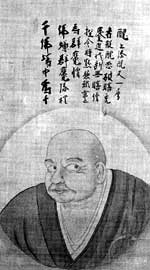 The most important reviver of the Rinzai tradition, and in some respects the
greatest figure in Japanese Rinzai Zen, was Hakuin Ekaku 白隱慧鶴 (1686–1769).
Hakuin was a native of the village of Hara in present Shizuoka Prefecture.
As a young boy he displayed a remarkable memory and strong character, but is
said to have been terrified by images of hell. At the age of fifteen he
became a monk at the nearby temple Shoin-ji 松蔭寺. At the age of nineteen he
had a crisis that caused him to leave meditation training for several years
and devote himself to the study of literature, but later, upon reading how
the Chinese master Shishuang Chuyuan 石霜楚圓 (J., Sekiso Soen; 986–1039) kept
himself awake during his meditation at night by sticking his thigh with an
awl, he returned to his zazen practice with renewed determination. At
twenty-four he had an awakening upon hearing the sound of a temple bell, an
experience he deeped through training under the master Dokyo Etan 道鏡慧端
(1642–1721) of Shoju-an 正受庵 in what is now Nagano Prefecture. Further
training and experiences followed, even after he returned to Suruga as abbot
of Shoin-ji. His decisive spiritual breakthrough occurred when he was
forty-two years old. The most important reviver of the Rinzai tradition, and in some respects the
greatest figure in Japanese Rinzai Zen, was Hakuin Ekaku 白隱慧鶴 (1686–1769).
Hakuin was a native of the village of Hara in present Shizuoka Prefecture.
As a young boy he displayed a remarkable memory and strong character, but is
said to have been terrified by images of hell. At the age of fifteen he
became a monk at the nearby temple Shoin-ji 松蔭寺. At the age of nineteen he
had a crisis that caused him to leave meditation training for several years
and devote himself to the study of literature, but later, upon reading how
the Chinese master Shishuang Chuyuan 石霜楚圓 (J., Sekiso Soen; 986–1039) kept
himself awake during his meditation at night by sticking his thigh with an
awl, he returned to his zazen practice with renewed determination. At
twenty-four he had an awakening upon hearing the sound of a temple bell, an
experience he deeped through training under the master Dokyo Etan 道鏡慧端
(1642–1721) of Shoju-an 正受庵 in what is now Nagano Prefecture. Further
training and experiences followed, even after he returned to Suruga as abbot
of Shoin-ji. His decisive spiritual breakthrough occurred when he was
forty-two years old.
Hakuin was tirelessly active in teaching the dharma. He traveled widely,
lectured on many of the basic Zen texts, and produced a large body of
writings, both in vernacular Japanese and classical Chinese. He started
systematization of the Rinzai koan curriculum, and attacked what he regarded
as distortions of Zen training, such as “silent illumination” zazen and the
practice of nenbutsu by Zen monks. He stressed the importance of bodhicitta,
in both its aspects of personal enlightenment (kensho) and the saving of all
sentient beings. His lineage now includes all masters of Rinzai Zen in
Japan.
The two monks in Hakuin’s lineage most influential in completing the koan
reform begun by Hakuin were Inzan Ien 隱山惟琰 (1751–1814) and Takuju Kosen
卓洲胡僊 (1760–1833). Inzan was a native of Echizen, present-day Fukui
Prefecture. He became a monk at the age of nine, and at sixteen began his
study of Zen under the Bankei-line master Bankoku 萬國(n.d.). After
three years he went to Gessen Zen’e 月船禪慧 (1702–1781), under whom he studied
for seven years. In 1789 he went for further study under Gasan Jito 峨山慈棹
(1727–1797), Gessen’s former student and an eminent successor of Hakuin
Ekaku. After two years he received recognition from Gasan, and went on to
teach in various temples, including Myoshin-ji and Zuiryo-ji 瑞龍寺. His
vigorous, dynamic style of Zen became one of the two streams of Hakuin Zen,
along with that of Takuju Kosen.
Takuju was born in Tajima, near the present-day city of Nagoya. He became a
monk at the age of fifteen at the temple Soken-ji 總見寺, and set out on
pilgrimage at nineteen. The following year he became a disciple of Gasan
Jito after hearing him lecture near Edo. He received transmission from the
master after fourteen years. Returning to Soken-ji, he devoted the rest of
his life to teaching the detailed style of Zen that came to characterize his
lineage, the Takuju school. The Obaku School
While the Rinzai school was developing independently in Japan from
the thirteenth to the seventeenth centuries, the Chinese Linji school
continued to evolve in its own way. Among the most noticeable changes were
the incorporation of the Guiyang, Caodong, Yunmen, and Fayan schools into
the Linji school, and the admixture of Pure Land and esoteric elements into
Zen practice.
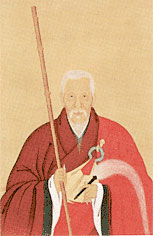 From before the Tokugawa period (1603–1868) Chinese Zen priests had lived in
the trading city of Nagasaki to serve the resident Chinese community there;
from the mid-seventeenth century Chinese Zen masters started to arrive at
the port to teach Zen as it was then practiced in China. The first to arrive
was Daozhe Chaoyuan 道者超元 (J., Doja Chogen, d. 1660), who taught in Nagasaki
from 1651 to 1658. However, the lineage that was to develop into the
Japanese Obaku school was that of the master Yinyuan Longqi 隱元隆琦 (J., Ingen
Ryuki, 1592–1673). From before the Tokugawa period (1603–1868) Chinese Zen priests had lived in
the trading city of Nagasaki to serve the resident Chinese community there;
from the mid-seventeenth century Chinese Zen masters started to arrive at
the port to teach Zen as it was then practiced in China. The first to arrive
was Daozhe Chaoyuan 道者超元 (J., Doja Chogen, d. 1660), who taught in Nagasaki
from 1651 to 1658. However, the lineage that was to develop into the
Japanese Obaku school was that of the master Yinyuan Longqi 隱元隆琦 (J., Ingen
Ryuki, 1592–1673).
Yinyuan was a native of Fuqing in present-day Fujian; his family name was
Lin. In his early life he was a farmer, but began spiritual training at the
age of twenty-three following a religious experience one night while sitting
under a tree. At the age of twenty-nine he entered the monkhood at the
temple Huangbo Wanfu si 黄檗萬福寺, then studied under a number of masters before
receiving transmission from Miyun Yuanwu 密雲圓悟 (J., Mitsu’un Engo; 1566–1642). When Miyun’s
student Feiyin Tongrong 費隠通容 (J., Hi’in Tsuyo; 1593–1661) assumed the abbacy of Huangbo Wanfu
si, Yinyuan became head monk under him and later was named Feiyin’s dharma
successor. Yinyuan subsequently served as abbot of several temples,
including Wanfu si.
In 1654 Yinyuan departed for Japan, landing in Nagasaki. There he became
abbot of Kofuku-ji 興福寺, and, the following year, also of nearby Sofuku-ji
崇福寺. Later in 1655 he was named abbot of Fumon-ji 普門寺 in present-day Osaka.
In 1661, with the support of the shogunate, a temple was founded for Yinyuan
in Uji, just south of Kyoto. Yinyuan named the new temple Manpuku-ji 萬福寺,
with the mountain-name Obaku-san 黄檗山, in honor of the community he had left
behind in China. Manpuku-ji was designed according to contemporary Chinese
temple architecture, and its rule followed the monastic code of its namesake
in China. In 1664 Yinyuan retired and was succeeded by his disciple Mu’an
Xingdao 木菴性瑫 (J., Mokuan Shoto, 1611–1684).
Manpuku-ji and the other monasteries established in Yinyuan’s lineage
remained strongly Chinese in character for many generations. The first
thirteen abbots of Manpuku-ji were all Chinese; the fourteenth abbot, Ryuto
Gento 龍統元棟 (1663–1746), was the first Japanese abbot, but he was followed by
a number of Chinese chief priests. The thirty-third abbot, Ryochu Nyoryu
良忠如隆 (1793–1868) was a Dharma successor of the important Hakuin-line master
Takuju Kosen; since that time the teachings of the school have become
increasingly similar to those of Japanese Rinzai Zen (all masters are now of
the Hakuin lineage), although many of the monastic customs of the Obaku
school remain distinctly those of Ming-dynasty Chinese Zen. Practices like
the nenbutsu and esoteric rituals have been retained, ceremonies such as
sutra-chanting are performed in the Chinese manner, and mealtime ettiquette
follows Chinese
customs. |


 The history of Zen Buddhism started with Gautama Shakyamuni’s awakening to the True Dharma, the Buddha-nature inherent in all
beings. The lineage of the Zen School is traditionally regarded as having commenced with Shakyamuni’s transmission of the Mind Seal
(inka shomei 印可証明) to his disciple Mahakashyapa (see “Buddha Mind School”). With Shakyamuni’s recognition of
Mahakashyapa began the “direct transmission from
master to disciple” that Zen emphasizes as the particular characteristic of
its history as a tradition.
The history of Zen Buddhism started with Gautama Shakyamuni’s awakening to the True Dharma, the Buddha-nature inherent in all
beings. The lineage of the Zen School is traditionally regarded as having commenced with Shakyamuni’s transmission of the Mind Seal
(inka shomei 印可証明) to his disciple Mahakashyapa (see “Buddha Mind School”). With Shakyamuni’s recognition of
Mahakashyapa began the “direct transmission from
master to disciple” that Zen emphasizes as the particular characteristic of
its history as a tradition. Among the successors of the Sixth Patriarch Huineng,
the two masters Nanyue Huairang 南嶽懷讓 (Nangaku
Ejo; 677–744) and Qingyuan Xingsi 青原行思 (J., Seigen Gyoshi; d. 740) were of
especial importance in the subsequent history of Zen, for it was their
lineages that produced all the later traditions of mainstream Chinese Zen ,
known, collectively, as the Five Houses. The Five Houses were:
Among the successors of the Sixth Patriarch Huineng,
the two masters Nanyue Huairang 南嶽懷讓 (Nangaku
Ejo; 677–744) and Qingyuan Xingsi 青原行思 (J., Seigen Gyoshi; d. 740) were of
especial importance in the subsequent history of Zen, for it was their
lineages that produced all the later traditions of mainstream Chinese Zen ,
known, collectively, as the Five Houses. The Five Houses were:
 Mahakashyapa was followed in the traditional Zen lineage by Ananda, the
Buddha’s cousin and attendant who had failed to attain enlightenment while
the Buddha was alive, but who awakened to the Buddha Mind through the
guidance of Mahakashyapa. The Indian lineage continued until the
twenty-eighth patriarch, Bodhidharma, who transmitted the Zen teachings to
China in the early sixth century. Bodhidharma was succeeded by his disciple Huike 慧可
(487–593), a Chinese monk who, when he first visited the master, is said to
have demonstrated his determination by cutting off his arm. His
enlightenment is traditionally described as follows:
Mahakashyapa was followed in the traditional Zen lineage by Ananda, the
Buddha’s cousin and attendant who had failed to attain enlightenment while
the Buddha was alive, but who awakened to the Buddha Mind through the
guidance of Mahakashyapa. The Indian lineage continued until the
twenty-eighth patriarch, Bodhidharma, who transmitted the Zen teachings to
China in the early sixth century. Bodhidharma was succeeded by his disciple Huike 慧可
(487–593), a Chinese monk who, when he first visited the master, is said to
have demonstrated his determination by cutting off his arm. His
enlightenment is traditionally described as follows: From Huike the Chinese patriarchate continued through Sengcan 僧璨 (the Third
Patriarch; d. 606?), Daoxin 道信 (the Fourth Patriarch; 580–651), and Hongren
弘忍 (the Fifth Patriarch; 600-674), to Huineng 慧能 (the Sixth Patriarch;
738ー713). Under Huineng, Zen took on a distinctly Chinese character with an
emphasis on “sudden awakening” to the Buddha-nature inherent in every being.
Huineng’s intuition of the universal nature of Buddha Mind was already
expressed in the story of his first encounter with the Fifth Patriarch:
It is said that when Huineng arrived at the monastery, Hongren asked about his origins.
Huineng replied that he had come from southern China. Hongren said that a
barbarian from the south can never become a Buddha. When Huineng responded,
“There is no north and south in Buddha nature,” Hongren sensed Huineng’s
ability and put him to work at the monastery as a rice huller.
From Huike the Chinese patriarchate continued through Sengcan 僧璨 (the Third
Patriarch; d. 606?), Daoxin 道信 (the Fourth Patriarch; 580–651), and Hongren
弘忍 (the Fifth Patriarch; 600-674), to Huineng 慧能 (the Sixth Patriarch;
738ー713). Under Huineng, Zen took on a distinctly Chinese character with an
emphasis on “sudden awakening” to the Buddha-nature inherent in every being.
Huineng’s intuition of the universal nature of Buddha Mind was already
expressed in the story of his first encounter with the Fifth Patriarch:
It is said that when Huineng arrived at the monastery, Hongren asked about his origins.
Huineng replied that he had come from southern China. Hongren said that a
barbarian from the south can never become a Buddha. When Huineng responded,
“There is no north and south in Buddha nature,” Hongren sensed Huineng’s
ability and put him to work at the monastery as a rice huller.  Three generations after Huineng, the master Baizhang Huaihai 百丈懷海 (J., Hyakujo Ekai; 749–814)
laid the foundations of the Zen monastic life, with manual labor as a
central part of the daily schedule (he is known for his famous dictum, “A
day of no work—a day of no eating”). His monastic rule, the Chanlin qinggui
禪林清規, no longer exists in its original form, but all subsequent forms of Zen
monasticism have been influenced by his ideas on meditation practice and
architectural design for the Zen monastery.
Three generations after Huineng, the master Baizhang Huaihai 百丈懷海 (J., Hyakujo Ekai; 749–814)
laid the foundations of the Zen monastic life, with manual labor as a
central part of the daily schedule (he is known for his famous dictum, “A
day of no work—a day of no eating”). His monastic rule, the Chanlin qinggui
禪林清規, no longer exists in its original form, but all subsequent forms of Zen
monasticism have been influenced by his ideas on meditation practice and
architectural design for the Zen monastery. 3) the Caodong 曹洞 (Jap., Soto) school, established by Qingyuan Xingsi’s
descendant Dongshan Liangjie 洞山良价 (J., Tozan Ryokai; 807–869) and Dongshan’s
student Caoshan Benji 曹山本寂 (J., Sozan Honjaku, 840–901);
3) the Caodong 曹洞 (Jap., Soto) school, established by Qingyuan Xingsi’s
descendant Dongshan Liangjie 洞山良价 (J., Tozan Ryokai; 807–869) and Dongshan’s
student Caoshan Benji 曹山本寂 (J., Sozan Honjaku, 840–901); The first Japanese monk
to transmit the Rinzai teachings to Japan was the Japanese Tendai monk Myoan
Yosai [Eisai] 明菴榮西 (1141–1215). Born in present
Okayama Prefecture, he became a Tendai-school monk at the age of eleven and
studied the esoteric teachings of that tradition. He went to the Tendai
headquarters on Mt. Hiei two years later, and was ordained in 1154. In 1168
he traveled to China, where he studied the Tiantai teachings and practiced
Tiantai meditation methods for six months before returning to Japan.
The first Japanese monk
to transmit the Rinzai teachings to Japan was the Japanese Tendai monk Myoan
Yosai [Eisai] 明菴榮西 (1141–1215). Born in present
Okayama Prefecture, he became a Tendai-school monk at the age of eleven and
studied the esoteric teachings of that tradition. He went to the Tendai
headquarters on Mt. Hiei two years later, and was ordained in 1154. In 1168
he traveled to China, where he studied the Tiantai teachings and practiced
Tiantai meditation methods for six months before returning to Japan.
 The most important reviver of the Rinzai tradition, and in some respects the
greatest figure in Japanese Rinzai Zen, was Hakuin Ekaku 白隱慧鶴 (1686–1769).
Hakuin was a native of the village of Hara in present Shizuoka Prefecture.
As a young boy he displayed a remarkable memory and strong character, but is
said to have been terrified by images of hell. At the age of fifteen he
became a monk at the nearby temple Shoin-ji 松蔭寺. At the age of nineteen he
had a crisis that caused him to leave meditation training for several years
and devote himself to the study of literature, but later, upon reading how
the Chinese master Shishuang Chuyuan 石霜楚圓 (J., Sekiso Soen; 986–1039) kept
himself awake during his meditation at night by sticking his thigh with an
awl, he returned to his zazen practice with renewed determination. At
twenty-four he had an awakening upon hearing the sound of a temple bell, an
experience he deeped through training under the master Dokyo Etan 道鏡慧端
(1642–1721) of Shoju-an 正受庵 in what is now Nagano Prefecture. Further
training and experiences followed, even after he returned to Suruga as abbot
of Shoin-ji. His decisive spiritual breakthrough occurred when he was
forty-two years old.
The most important reviver of the Rinzai tradition, and in some respects the
greatest figure in Japanese Rinzai Zen, was Hakuin Ekaku 白隱慧鶴 (1686–1769).
Hakuin was a native of the village of Hara in present Shizuoka Prefecture.
As a young boy he displayed a remarkable memory and strong character, but is
said to have been terrified by images of hell. At the age of fifteen he
became a monk at the nearby temple Shoin-ji 松蔭寺. At the age of nineteen he
had a crisis that caused him to leave meditation training for several years
and devote himself to the study of literature, but later, upon reading how
the Chinese master Shishuang Chuyuan 石霜楚圓 (J., Sekiso Soen; 986–1039) kept
himself awake during his meditation at night by sticking his thigh with an
awl, he returned to his zazen practice with renewed determination. At
twenty-four he had an awakening upon hearing the sound of a temple bell, an
experience he deeped through training under the master Dokyo Etan 道鏡慧端
(1642–1721) of Shoju-an 正受庵 in what is now Nagano Prefecture. Further
training and experiences followed, even after he returned to Suruga as abbot
of Shoin-ji. His decisive spiritual breakthrough occurred when he was
forty-two years old.
 From before the Tokugawa period (1603–1868) Chinese Zen priests had lived in
the trading city of Nagasaki to serve the resident Chinese community there;
from the mid-seventeenth century Chinese Zen masters started to arrive at
the port to teach Zen as it was then practiced in China. The first to arrive
was Daozhe Chaoyuan 道者超元 (J., Doja Chogen, d. 1660), who taught in Nagasaki
from 1651 to 1658. However, the lineage that was to develop into the
Japanese Obaku school was that of the master Yinyuan Longqi 隱元隆琦 (J., Ingen
Ryuki, 1592–1673).
From before the Tokugawa period (1603–1868) Chinese Zen priests had lived in
the trading city of Nagasaki to serve the resident Chinese community there;
from the mid-seventeenth century Chinese Zen masters started to arrive at
the port to teach Zen as it was then practiced in China. The first to arrive
was Daozhe Chaoyuan 道者超元 (J., Doja Chogen, d. 1660), who taught in Nagasaki
from 1651 to 1658. However, the lineage that was to develop into the
Japanese Obaku school was that of the master Yinyuan Longqi 隱元隆琦 (J., Ingen
Ryuki, 1592–1673).